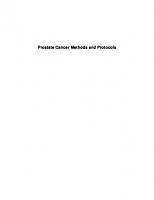NEJM Lutetium-177–PSMA-617 for Metastatic Castration-Resistant Prostate Cancer
204 33 184KB
English Pages [13]
Recommend Papers

- Author / Uploaded
- O. Sartor
- J. de Bono
- K.N. Chi
- K. Fizazi
- K. Herrmann
- K. Rahbar
- S.T. Tagawa
- L.T. Nordquist
- N. Vaishampayan
- G. El‑Haddad
- C.H. Park
- T.M. Beer
- A. Armour
- W.J. Pérez‑Contreras
- M. DeSilvio
- E. Kpamegan
- G. Gericke
- R.A. Messmann
- M.J. Morris
- and B.J. Krause
- Similar Topics
- Medicine
File loading please wait...
Citation preview
The
n e w e ng l a n d j o u r na l
of
m e dic i n e
Original Article
Lutetium-177–PSMA-617 for Metastatic Castration-Resistant Prostate Cancer O. Sartor, J. de Bono, K.N. Chi, K. Fizazi, K. Herrmann, K. Rahbar, S.T. Tagawa, L.T. Nordquist, N. Vaishampayan, G. El‑Haddad, C.H. Park, T.M. Beer, A. Armour, W.J. Pérez‑Contreras, M. DeSilvio, E. Kpamegan, G. Gericke, R.A. Messmann, M.J. Morris, and B.J. Krause, for the VISION Investigators*
A BS T R AC T BACKGROUND
Metastatic castration-resistant prostate cancer remains fatal despite recent advances. Prostate-specific membrane antigen (PSMA) is highly expressed in metastatic castration-resistant prostate cancer. Lutetium-177 (177Lu)–PSMA-617 is a radioligand therapy that delivers beta-particle radiation to PSMA-expressing cells and the surrounding microenvironment.
The authors’ full names, academic de‑ grees, and affiliations are listed in the Ap‑ pendix. Address reprint requests to Dr. Sartor at Tulane Cancer Center, School of Medicine, Tulane University, New Orleans, LA 70112, or at [email protected].
METHODS
*The list of the VISION investigators is provided in the Supplementary Appen‑ dix, available at NEJM.org.
We conducted an international, open-label, phase 3 trial evaluating Lu-PSMA-617 in patients who had metastatic castration-resistant prostate cancer previously treated with at least one androgen-receptor–pathway inhibitor and one or two taxane regimens and who had PSMA-positive gallium-68 (68Ga)–labeled PSMA-11 positronemission tomographic–computed tomographic scans. Patients were randomly assigned in a 2:1 ratio to receive either 177Lu-PSMA-617 (7.4 GBq every 6 weeks for four to six cycles) plus protocol-permitted standard care or standard care alone. Protocol-permitted standard care excluded chemotherapy, immunotherapy, radium-223 (223Ra), and investigational drugs. The alternate primary end points were imagingbased progression-free survival and overall survival, which were powered for hazard ratios of 0.67 and 0.73, respectively. Key secondary end points were objective response, disease control, and time to symptomatic skeletal events. Adverse events during treatment were those occurring no more than 30 days after the last dose and before subsequent anticancer treatment. 177
RESULTS
From June 2018 to mid-October 2019, a total of 831 of 1179 screened patients underwent randomization. The baseline characteristics of the patients were balanced between the groups. The median follow-up was 20.9 months. 177Lu-PSMA-617 plus standard care significantly prolonged, as compared with standard care, both imaging-based progression-free survival (median, 8.7 vs. 3.4 months; hazard ratio for progression or death, 0.40; 99.2% confidence interval [CI], 0.29 to 0.57; P

![Salvage Therapy for Prostate Cancer [1 ed.]
9783030571801, 9783030571818](https://ebin.pub/img/200x200/salvage-therapy-for-prostate-cancer-1nbsped-9783030571801-9783030571818.jpg)

![Prostate Specific Antigen and Prostate Cancer [1 ed.]
9781621005865, 9781612098364](https://ebin.pub/img/200x200/prostate-specific-antigen-and-prostate-cancer-1nbsped-9781621005865-9781612098364.jpg)


![A History of Prostate Cancer: Cancer, Men and Medicine [1 ed.]
9781137565952, 2016948766](https://ebin.pub/img/200x200/a-history-of-prostate-cancer-cancer-men-and-medicine-1nbsped-9781137565952-2016948766.jpg)
![Therapeutic Management of Metastatic Breast Cancer [First named authors: K. W. Brunner Reprint 2019]
9783110888942, 9783110121827](https://ebin.pub/img/200x200/therapeutic-management-of-metastatic-breast-cancer-first-named-authors-k-w-brunner-reprint-2019-9783110888942-9783110121827.jpg)
![Prostate Cancer Methods and Protocols (Methods in Molecular Medicine) [1 ed.]
9780896039780, 9781592593729, 0896039781](https://ebin.pub/img/200x200/prostate-cancer-methods-and-protocols-methods-in-molecular-medicine-1nbsped-9780896039780-9781592593729-0896039781.jpg)
